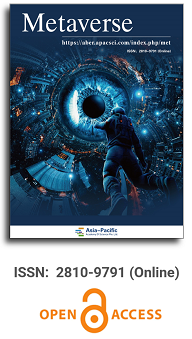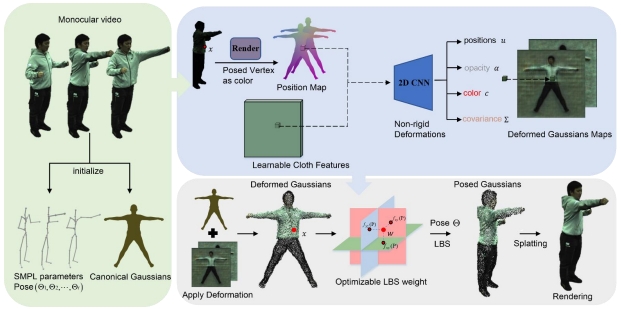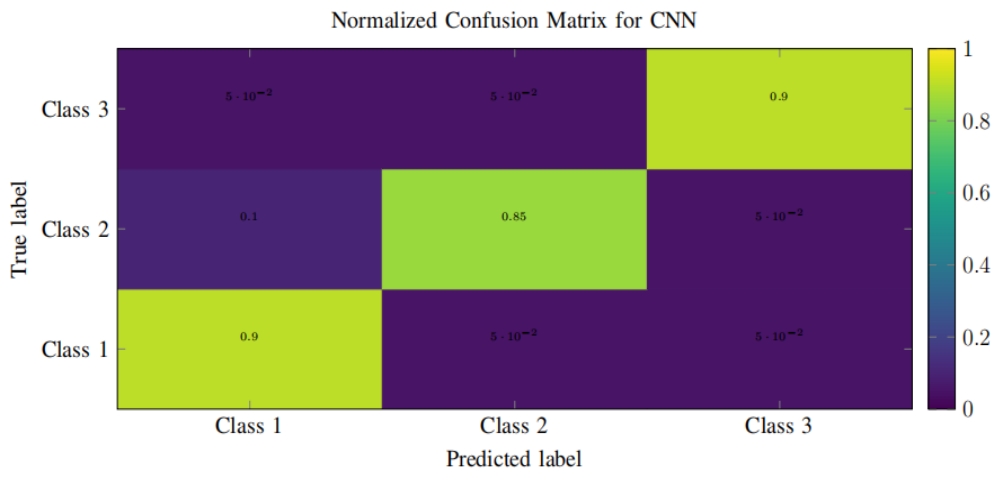
Asia Pacific Academy of Science Pte. Ltd. (APACSCI) specializes in international journal publishing. APACSCI adopts the open access publishing model and provides an important communication bridge for academic groups whose interest fields include engineering, technology, medicine, computer, mathematics, agriculture and forestry, and environment.



Survey on haptic technologies for virtual reality applications during COVID-19
Vol 5, Issue 2, 2024
Download PDF
Abstract
This paper presents a comprehensive survey on the advancements and applications of haptic technologies, which are methods that facilitate the sense of touch and movement, in virtual reality (VR) during the COVID-19 pandemic. It aims to identify and classify the various domains in which haptic technologies have been utilized or can be adapted to combat the unique challenges posed by the pandemic or public health emergencies in general. Existing reviews and surveys that concentrate on the applications of haptic technologies during the Covid-19 pandemic are often limited to specific domains; this survey strives to identify and consolidate all application domains discussed in the literature, including healthcare, medical training, education, social communication, and fashion and retail. Original research and review articles were collected from the Web of Science Core Collection as the main source, using a combination of keywords (like ‘haptic’, ‘haptics’, ‘touch interface’, ‘tactile’, ‘virtual reality’, ‘augmented reality’, ‘Covid-19’, and ‘pandemic’) and Boolean operators to refine the search and yield relevant results. The paper reviews various haptic devices and systems and discusses the technological advancements that have been made to offer more realistic and immersive VR experiences. It also addresses challenges in haptic technology in VR, including fidelity, ethical, and privacy considerations, and cost and accessibility issues.
Keywords
References
- Motaharifar M, Norouzzadeh A, Abdi P, et al. Applications of Haptic Technology, Virtual Reality, and Artificial Intelligence in Medical Training During the COVID-19 Pandemic. Frontiers in Robotics and AI. 2021; 8. doi: 10.3389/frobt.2021.612949
- Hatzfeld C, Kern TA. Motivation and application of haptic systems. Springer London; 2014.
- Hatzfeld C, Kern TA. Haptics as an interaction modality. Springer London; 2014.
- Tong Q, Wei W, Zhang Y, et al. Survey on Hand-Based Haptic Interaction for Virtual Reality. IEEE Transactions on Haptics. 2023; 16(2): 154-170. doi: 10.1109/toh.2023.3266199
- Bermejo C, Hui P. A Survey on Haptic Technologies for Mobile Augmented Reality. ACM Computing Surveys. 2021; 54(9): 1-35. doi: 10.1145/3465396
- Abdi E, Kulic D, Croft E. Haptics in Teleoperated Medical Interventions: Force Measurement, Haptic Interfaces and Their Influence on User’s Performance. IEEE Transactions on Biomedical Engineering. 2020; 67(12): 3438-3451. doi: 10.1109/tbme.2020.2987603
- Zhu Y, Li N. Virtual and augmented reality technologies for emergency management in the built environments: A state-of-the-art review. Journal of Safety Science and Resilience. 2021; 2(1): 1-10. doi: 10.1016/j.jnlssr.2020.11.004
- Imran E, Adanir N, Khurshid Z. Significance of Haptic and Virtual Reality Simulation (VRS) in the Dental Education: A Review of Literature. Applied Sciences. 2021; 11(21): 10196. doi: 10.3390/app112110196
- Kovanur Sampath K, Arumugam A, Yaghi E, et al. The role of virtual reality (VR) with haptic feedback in enhancing physical examination skills of health care students – A systematic review protocol. International Journal of Osteopathic Medicine. 2022; 46: 51-54. doi: 10.1016/j.ijosm.2022.10.008
- See AR, Choco JAG, Chandramohan K. Touch, Texture and Haptic Feedback: A Review on How We Feel the World around Us. Applied Sciences. 2022; 12(9): 4686. doi: 10.3390/app12094686
- Adilkhanov A, Rubagotti M, Kappassov Z. Haptic Devices: Wearability-Based Taxonomy and Literature Review. IEEE Access. 2022; 10: 91923-91947. doi: 10.1109/access.2022.3202986
- Handelzalts S, Ballardini G, Avraham C, et al. Integrating Tactile Feedback Technologies Into Home-Based Telerehabilitation: Opportunities and Challenges in Light of COVID-19 Pandemic. Frontiers in Neurorobotics. 2021; 15. doi: 10.3389/fnbot.2021.617636
- Su YP, Chen XQ, Zhou C, et al. Integrating Virtual, Mixed, and Augmented Reality into Remote Robotic Applications: A Brief Review of Extended Reality-Enhanced Robotic Systems for Intuitive Telemanipulation and Telemanufacturing Tasks in Hazardous Conditions. Applied Sciences. 2023; 13(22): 12129. doi: 10.3390/app132212129
- Sanfilippo F, Blazauskas T, Salvietti G, et al. A Perspective Review on Integrating VR/AR with Haptics into STEM Education for Multi-Sensory Learning. Robotics. 2022; 11(2): 41. doi: 10.3390/robotics11020041
- Sahi RS, Schwyck ME, Parkinson C, et al. Having more virtual interaction partners during COVID-19 physical distancing measures may benefit mental health. Scientific Reports. 2021; 11(1). doi: 10.1038/s41598-021-97421-1
- Ipakchian Askari S, Huisman G, Haans A, IJsselsteijn WA. Exploring views on affective haptic devices in times of COVID-19. Frontiers in Computer Science. 2022; 4: 795927.
- Faisal M, Laamarti F, El Saddik A. Digital Twin Haptic Robotic Arms: Towards Handshakes in the Metaverse. Electronics. 2023; 12(12): 2603. doi: 10.3390/electronics12122603
- Haynes AC, Lywood A, Crowe EM, et al. A calming hug: Design and validation of a tactile aid to ease anxiety. Plos One. 2022; 17(3): e0259838. doi: 10.1371/journal.pone.0259838
- Cheok AD, Zhang EY. Electrical machine for remote kissing, and engineering measurement of its remote communication effects, including modified Turing test. Journal of Future Robot Life. 2020; 1(1): 111-134. doi: 10.3233/frl-200006
- Sahay S, Wei W. “Everything Is Changing, but I Am Not Alone”: Nurses’ Perceptions of Social Support during COVID-19. Sustainability. 2022; 14(6): 3262. doi: 10.3390/su14063262
- Burleson MH, Davis TS, Kasch CM, et al. Affectionate touch to promote relational, psychological, and physical well-being in adulthood: a theoretical model and review of the research. Pers Soc Psychol Rev. 2017; 21(3): 228-252. doi: 10.1177/1088868316650307
- Wee C, Yap KM, Lim WN. Haptic Interfaces for Virtual Reality: Challenges and Research Directions. IEEE Access. 2021; 9: 112145-112162. doi: 10.1109/access.2021.3103598
- Kenyon K, Kinakh V, Harrison J. Social virtual reality helps to reduce feelings of loneliness and social anxiety during the Covid-19 pandemic. Scientific Reports. 2023; 13(1). doi: 10.1038/s41598-023-46494-1
- Ozioko O, Dahiya R. Smart Tactile Gloves for Haptic Interaction, Communication, and Rehabilitation. Advanced Intelligent Systems. 2021; 4(2). doi: 10.1002/aisy.202100091
- Kang D, Lee CG, Kwon O. Pneumatic and acoustic suit: multimodal haptic suit for enhanced virtual reality simulation. Virtual Reality. 2023. doi: 10.1007/s10055-023-00756-5
- Cang XL, Israr A, MacLean KE. When is a Haptic Message Like an Inside Joke? Digitally Mediated Emotive Communication Builds on Shared History. IEEE Transactions on Affective Computing. 2023; 14(1): 732-746. doi: 10.1109/taffc.2023.3244520
- Akhtar N, Kumar A, Mattoo B, et al. Introducing virtual classrooms for undergraduate physiology teaching during the COVID-19 pandemic: acceptance by students and subjective impact on learning. Advances in Physiology Education. 2023; 47(3): 376-382. doi: 10.1152/advan.00252.2022
- Jiang B, Li X, Liu S, et al. Experience of Online Learning from COVID-19: Preparing for the Future of Digital Transformation in Education. International Journal of Environmental Research and Public Health. 2022; 19(24): 16787. doi: 10.3390/ijerph192416787
- Sinou N, Sinou N, Filippou D. Virtual Reality and Augmented Reality in Anatomy Education During COVID-19 Pandemic. Cureus. 2023. doi: 10.7759/cureus.35170
- Zhang Z, Li Z, Han M, et al. An augmented reality-based multimedia environment for experimental education. Multimedia Tools and Applications. 2020; 80(1): 575-590. doi: 10.1007/s11042-020-09684-x
- Edwards BI, Bielawski KS, Prada R, et al. Haptic virtual reality and immersive learning for enhanced organic chemistry instruction. Virtual Reality. 2018; 23(4): 363-373. doi: 10.1007/s10055-018-0345-4
- Marichal S, Rosales A, González Perilli F, et al. Auditory and haptic feedback to train basic mathematical skills of children with visual impairments. Behaviour & Information Technology. 2022; 42(8): 1081-1109. doi: 10.1080/0144929x.2022.2060860
- Espinosa-Castaneda R, Medellin-Castillo HI. Virtual Haptic Perception as an Educational Assistive Technology: A Case Study in Inclusive Education. IEEE Transactions on Haptics. 2021; 14(1): 152-160. doi: 10.1109/toh.2020.3001586
- Sghaier S, Elfakki AO, Alotaibi AA. Development of an intelligent system based on metaverse learning for students with disabilities. Frontiers in Robotics and AI. 2022; 9. doi: 10.3389/frobt.2022.1006921
- Coles TR, Meglan D, John NW. The Role of Haptics in Medical Training Simulators: A Survey of the State of the Art. IEEE Transactions on Haptics. 2011; 4(1): 51-66. doi: 10.1109/toh.2010.19
- Ullrich S, Kuhlen T. Haptic Palpation for Medical Simulation in Virtual Environments. IEEE Transactions on Visualization and Computer Graphics. 2012; 18(4): 617-625. doi: 10.1109/tvcg.2012.46
- Tjønnås MS, Das A, Våpenstad C, et al. Simulation-based skills training: a qualitative interview study exploring surgical trainees’ experience of stress. Advances in Simulation. 2022; 7(1). doi: 10.1186/s41077-022-00231-2
- Rangarajan K, Davis H, Pucher PH. Systematic Review of Virtual Haptics in Surgical Simulation: A Valid Educational Tool? Journal of Surgical Education. 2020; 77(2): 337-347. doi: 10.1016/j.jsurg.2019.09.006
- Kim DH, Kim HM, Park JS, et al. Virtual Reality Haptic Simulator for Endoscopic Sinus and Skull Base Surgeries. Journal of Craniofacial Surgery. 2020; 31(6): 1811-1814. doi: 10.1097/scs.0000000000006395
- de Lotbiniere-Bassett M, Volpato Batista A, Lai C, et al. The user experience design of a novel microscope within SurgiSim, a virtual reality surgical simulator. International Journal of Computer Assisted Radiology and Surgery. 2022; 18(1): 85-93. doi: 10.1007/s11548-022-02727-8
- Li Z, Kiiveri M, Rantala J, et al. Evaluation of haptic virtual reality user interfaces for medical marking on 3D models. International Journal of Human-Computer Studies. 2021; 147: 102561. doi: 10.1016/j.ijhcs.2020.102561
- Tai Y, Qian K, Huang X, et al. Intelligent Intraoperative Haptic-AR Navigation for COVID-19 Lung Biopsy Using Deep Hybrid Model. IEEE Transactions on Industrial Informatics. 2021; 17(9): 6519-6527. doi: 10.1109/tii.2021.3052788
- San Diego JP, Newton TJ, Sagoo AK, et al. Learning Clinical Skills Using Haptic vs. Phantom Head Dental Chair Simulators in Removal of Artificial Caries: Cluster-Randomized Trials with Two Cohorts’ Cavity Preparation. Dentistry Journal. 2022; 10(11): 198. doi: 10.3390/dj10110198
- Clemente MP, Moreira A, Pinto JC, et al. The Challenge of Dental Education After COVID-19 Pandemic – Present and Future Innovation Study Design. INQUIRY: The Journal of Health Care Organization, Provision, and Financing. 2021; 58. doi: 10.1177/00469580211018293
- Al‐Saud LM. The utility of haptic simulation in early restorative dental training: A scoping review. Journal of Dental Education. 2020; 85(5): 704-721. doi: 10.1002/jdd.12518
- Giri GS, Maddahi Y, Zareinia K. An Application-Based Review of Haptics Technology. Robotics. 2021; 10(1): 29. doi: 10.3390/robotics10010029
- Liu Z, Bible J, Wells J, et al. Examining the Effect of Haptic Factors for Vascular Palpation Skill Assessment Using an Affordable Simulator. IEEE Open Journal of Engineering in Medicine and Biology. 2020; 1: 228-234. doi: 10.1109/ojemb.2020.3017156
- Jang SY, Ha J. The influence of tactile information on the human evaluation of tactile properties. Fashion and Textiles. 2021; 8(1). doi: 10.1186/s40691-020-00242-5
- Ornati M, Kalbaska N. Looking for haptics. Touch digitalization business strategies in luxury and fashion during COVID-19 and beyond. Digital Business. 2022; 2(2): 100035.
- Wilfling J, Havenith G, Raccuglia M, et al. Can you see the feel? The absence of tactile cues in clothing e-commerce impairs consumer decision making. International Journal of Fashion Design, Technology and Education. 2022; 16(2): 224-233. doi: 10.1080/17543266.2022.2154396
- Weiland B, Leclinche F, Kaci A, et al. Tactile simulation of textile fabrics: Design of simulation signals with regard to fingerprint. Tribology International. 2024; 191: 109113. doi: 10.1016/j.triboint.2023.109113
- Ege ES, Balikci A. Transparent Localized Haptics: Utilization of PVDF Actuators on Touch Displays. Actuators. 2023; 12(7): 289. doi: 10.3390/act12070289
- Jang SY, Ha J. Presenting fabrics in digital environment: fashion designers’ perspectives on communicating tactile qualities of the fabrics. Fashion and Textiles. 2023; 10(1). doi: 10.1186/s40691-022-00328-2
- Cheng L, Kalvandi M, McKinstry S, et al. Application of DenTeach in Remote Dentistry Teaching and Learning During the COVID-19 Pandemic: A Case Study. Frontiers in Robotics and AI. 2021; 7. doi: 10.3389/frobt.2020.611424
- Affan M, Khan H, Ahmed S, et al. Haptic-enabled Virtual Laboratory for Hands-on E-Learning: A Technology for and Beyond the Pandemic Era. 2021 International Conference on Robotics and Automation in Industry (ICRAI). 2021; 33: 1-6. doi: 10.1109/icrai54018.2021.9651428
- Chu R, Zhang Y, Zhang H, et al. Co-actuation: a method for achieving high stiffness and low inertia for haptic devices. IEEE transactions on haptics. 2019; 13(2): 312-24.
- Kastor N, Dandu B, Bassari V, Reardon G, Visell Y. Ferrofluid electromagnetic actuators for high-fidelity haptic feedback. Sensors and Actuators A: Physical. 2023; 355: 114252.
- Pediredla VK, Chandrasekaran K, Annamraju S, Thondiyath A. Design and realization of a novel haptic graspable interface for augmenting touch sensations. Frontiers in Robotics and AI. 2022; 9: 927660.
- Kim K, Yang H, Lee J, Lee WG. Metaverse wearables for immersive digital healthcare: a review. Advanced Science. 2023; 10(31): 2303234.
- Ley M, Rambukkana N. Touching at a distance: digital intimacies, haptic platforms, and the ethics of consent. Science and Engineering Ethics. 2021; 27: 1-7.
- Wang F, Qian Z, Lin Y, Zhang W. Design and rapid construction of a cost-effective virtual haptic device. IEEE/ASME Transactions on Mechatronics. 2020; 26(1): 66-77.
- Vlek SL, Burm R, Govers TM, Vleugels MP, et al. Potential value of haptic feedback in minimally invasive surgery for deep endometriosis. Surgical innovation. 2020; 27(6): 623-632.
Supporting Agencies
Copyright (c) 2024 Emma Yann Zhang, Adrian David Cheok, Zhigeng Pan, Jun Cai, Ying Yan
License URL: https://creativecommons.org/licenses/by/4.0/

This site is licensed under a Creative Commons Attribution 4.0 International License (CC BY 4.0).

Prof. Zhigeng Pan
Professor, Hangzhou International Innovation Institute (H3I), Beihang University, China

Prof. Jianrong Tan
Academician, Chinese Academy of Engineering, China
Conference Time
December 15-18, 2025
Conference Venue
Hong Kong Convention and Exhibition Center (HKCEC)
...
Metaverse Scientist Forum No.3 was successfully held on April 22, 2025, from 19:00 to 20:30 (Beijing Time)...
We received the Scopus notification on April 19th, confirming that the journal has been successfully indexed by Scopus...
We are pleased to announce that we have updated the requirements for manuscript figures in the submission guidelines. Manuscripts submitted after April 15, 2025 are required to strictly adhere to the change. These updates are aimed at ensuring the highest quality of visual content in our publications and enhancing the overall readability and impact of your research. For more details, please find it in sumissions...






.jpg)
.jpg)

